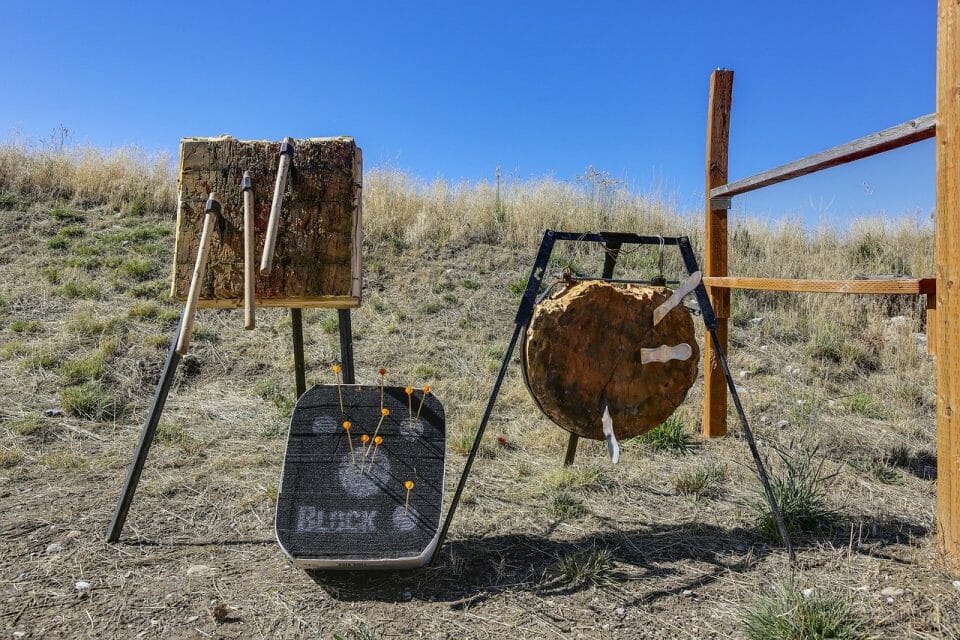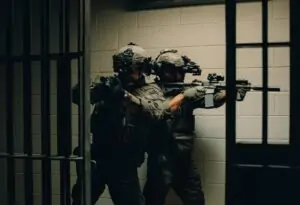
 You’ve just finished an Expendables marathon and you’re feeling like the next Lee Christmas. That is until you stick that knife somewhere it shouldn’t be. Don’t let that put you down though, you just need to learn the right technique and practice it enough. Preferably not at a human target, not right away at least.
You’ve just finished an Expendables marathon and you’re feeling like the next Lee Christmas. That is until you stick that knife somewhere it shouldn’t be. Don’t let that put you down though, you just need to learn the right technique and practice it enough. Preferably not at a human target, not right away at least.
Knife throwing, or impalement arts, has become quite popular in the 19th and 20th centuries. It was a show off for skill and accuracy, where a thrower hurls his knives breathtakingly close to a human target. It’s still quite as popular today, practiced as a sport that’s full of both fun and adrenaline. You can avoid accidentally taking out anyone’s eyes out with some tips and practice, just how Michael Pearl’s Knife and Tomahawk Throwing for Fun DVD shows you how to perfect just the right technique to throw your knives.
The Science of Throwing
Like darts, the goal in knife throwing is to hit a target. However, knives do not travel through the air like arrows. As you swing your arm toward the release point, you impart two kinds of motion to the knife:
- First, you move it in a partial circle around your shoulder joint.
- Second, you create spin. How? Because velocity = distance / time. By the time you’ve completed your swing, the outer end of the knife has moved a greater distance than the end that you are gripping, but in the same amount of time. This differential motion imparts spin, which is influenced by the center of mass, which is why knife balance is so crucial.
Physics then explains to us the path the knife takes: A revolving object that suddenly breaks free will continue to move in a straight line tangential to the point at which it was released. For this reason, the release point for a knife throw occurs much earlier than most people expect – at the top of the arc, not at your arm full extension. If you let go at the end of your throw, the knife would instead fly into the ground.
Once released, the knife flies toward the target at a speed averaging between 26 and 30 mph (42 to 48 kph). If you’ve brought all the throwing elements together properly, then the knife completes its rotation just as the business endpoints perpendicular to the target.
Some other factors come into play when throwing a knife, like its weight, the distance you throw it from, and your form when throwing it.
Choosing the Knife
Good-quality throwing knives are forged from heat-treated alloy steel, and they can last a lifetime. Other qualities a good throwing knife would have are:
- Dull edges
- Sharp point
- Rounded corners
- Thick enough the tip will not bend on impact
- Least perforations or cut-outs in the design
- No fancy grips or handles
- Weigh at least 10 to 12 ounces
- At least 12 inches long
As a beginner, go for simple designs without embellishments. This will help you learn to throw more accurately and plain knives are easier to throw.
How to Hold a Throwing Knife
A lot of people will adversely hold the knife so that their thumb is on the side of the knife and will release it so that the blade is vertical to the target. Instead, you may want to try this method:
- Place your index, middle, and ring fingers dead center on the handle (in case your knife is blade-heavy). Your little finger can just hang off the end.
- Place your thumb directly on the center of the other side of the handle.
- When you release the knife, you just open your hand. No interference with the knife.
How To Throw a Knife
There are three kinds of knives you can use for knife throwing: handle-heavy, blade-heavy, and balanced. Most professional throwers use a balanced knife, however, if you’re just getting started, go for blade or handle heavy knife. They have a much easier learning curve than a balanced knife.
Whether you throw by handle or blade, whether your preferred missile is a knife, ax, tomahawk or some other pointy object, the basic rule of throwing is the same: Grip the light end and throw heavy-end first.
Here’s a basic outline of the steps.
- Raise your arm over your head with your elbow slightly bent.
- Swing your arm, from the shoulder, forward and downward.
- Let go with your hand pointed forward, opening your hand to release the knife without snapping your wrist.
- After the release, follow through with your arm.
They key is to be very consistent. When throwing the knife, you must release the blade in exactly the same way, and at exactly the same position, every time. Once you determine the distance (between the release point and the target face) that results in a stick, make sure to toss from that distance each time.
Creating a Target
As we’ve established, you need to start practicing to improve your odds of landing shots. Avoid using trees, as repeated knife wounds will kill it.
Instead, you can build a target from a soft wood like pine, with the grain running vertically to permit easier sticking. You may also lay ¾-inch-thick planks side by side, mount them on a large 4- by 8-foot sheet of plywood, and then mark your target with five concentric circles. Or you can look up any of the DIY targets to create yourself.
The way you place your target is very important. Find an open area where you can see at least 30 feet in all directions, or set your target against a long continuous wall with no doors and windows. Since missing the target will cause your knife to hit the ground, a hard surface will be hard on your knife. Instead, throw on grass, and keep the growth short. That way, if the knife falls and buries itself in the dirt, you’ll be able to find it easily.

Remember: Safety First.
Always keep these safety tips in mind:
- Always wear closed-toe shoes (in case you drop a knife), eye protection, and beware of the knife glancing or bouncing back off of the target if it does not stick.
- Keep pets and children away and make sure you are in a safe area outside.
- Throw only in areas suitable for knife throwing.
- Use knives specially made for throwing. Typically the blade is dull, so it won’t cut your hand, and the tip is sharp to stick in the target.
- Inspect the knife frequently to make sure it is in good shape. If you notice a flaw, make repairs promptly. For example, keep that tip sharp.
- Don’t run with knives or point your blade at other people.
- When not in use, cover the blade of your knife in a sheath or store it in a box.
- If you injure yourself, seek first aid immediately.
Why Learn Knife Throwing?
So you might ask yourself, “Why do I need to learn knife throwing?” Well, it’s pretty obvious, isn’t it? Because why not! Knife throwing might just be the coolest skill you can show off, and it’s super fun once you get to master it. Not to mention that you’ll be able to cleave razor sharp shiny things through the air when you’re done. (And actually hit what you were aiming at). If, however, you’re looking for serious reasons to learn knife throwing… then how else do you plan on fighting off the zombie breakout?









